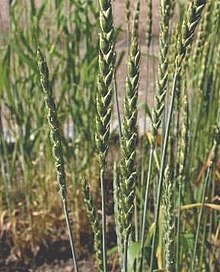Spelt
| Spelt | |
|---|---|
 |
|
| Scientific classification | |
| Kingdom: | Plantae |
| (unranked): | Angiosperms |
| (unranked): | Monocotyledons |
| (unranked): | Commelinids |
| Order: | Poales |
| Family: | Poaceae |
| Genus: | Triticum |
| Species: | T. spelta |
| Binomial name | |
|
Triticum spelta L. |
|
| Synonyms | |
|
|
| Nutritional value per 100 g (3.5 oz) | |
|---|---|
| Energy | 1,415 kJ (338 kcal) |
|
70.19 g
|
|
| Starch | 53.92 g |
| Dietary fibre | 10.7 g |
|
2.43 g
|
|
| Polyunsaturated | 1.258 g |
|
14.57 g
|
|
| Vitamins | |
| Thiamine (B1) |
(32%)
0.364 mg |
| Riboflavin (B2) |
(9%)
0.113 mg |
| Niacin (B3) |
(46%)
6.843 mg |
| Vitamin B6 |
(18%)
0.230 mg |
| Folate (B9) |
(11%)
45 μg |
| Vitamin E |
(5%)
0.79 mg |
| Minerals | |
| Calcium |
(3%)
27 mg |
| Iron |
(34%)
4.44 mg |
| Magnesium |
(38%)
136 mg |
| Manganese |
(143%)
3.0 mg |
| Phosphorus |
(57%)
401 mg |
| Potassium |
(8%)
388 mg |
| Sodium |
(1%)
8 mg |
| Zinc |
(35%)
3.28 mg |
| Other constituents | |
| Water | 11.02 g |
|
|
|
|
|
| Percentages are roughly approximated using US recommendations for adults. | |
Spelt (Triticum spelta), also known as dinkel wheat, or hulled wheat, is a species of wheat cultivated since approximately 5000 BC.
Spelt was an important staple in parts of Europe from the Bronze Age to medieval times; it now survives as a relict crop in Central Europe and northern Spain and has found a new market as a health food. Spelt is sometimes considered a subspecies of the closely related species common wheat (Triticum aestivum), in which case its botanical name is considered to be Triticum aestivum subsp. spelta. It is a hexaploid wheat, which means it has six sets of chromosomes. Over the years 2004 to 2014, spelt gained widespread popularity as a wheat substitute for making artisan breads, pasta and cereals.
Spelt has a complex history. It is a wheat species known from genetic evidence to have originated as a naturally occurring hybrid of a domesticated tetraploid wheat such as emmer wheat and the wild goat-grass Aegilops tauschii. This hybridisation must have taken place in the Near East because this is where Aegilops tauschii grows, and it must have taken place before the appearance of common or bread wheat (Triticum aestivum, a hexaploid free-threshing derivative of spelt) in the archaeological record about 8,000 years ago.
Genetic evidence shows that spelt wheat can also arise as the result of hybridisation of bread wheat and emmer wheat, although only at some date following the initial Aegilops–tetraploid wheat hybridisation. The much later appearance of spelt in Europe might thus be the result of a later, second, hybridisation between emmer and bread wheat. Recent DNA evidence supports an independent origin for European spelt through this hybridisation. Whether spelt has two separate origins in Asia and Europe, or single origin in the Near East, is currently unresolved.
...
Wikipedia
